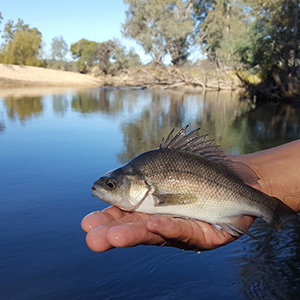Larval fish sensitivity to a simulated cold-water pulse varies between species and age

Accepted: 27 June 2022
Supplementary: 167
HTML: 135
All claims expressed in this article are solely those of the authors and do not necessarily represent those of their affiliated organizations, or those of the publisher, the editors and the reviewers. Any product that may be evaluated in this article or claim that may be made by its manufacturer is not guaranteed or endorsed by the publisher.
Authors
The release of cold-water from hypolimnetic zones of impoundments sharply reduces downstream riverine water temperature. This cold-water pollution (CWP) can extend for hundreds of kilometres, severely challenging the physiological ability of aquatic fauna, particularly ectotherms such as fish, to maintain essential processes such as metabolism, development and growth and survival. The impact of CWP on native fish, especially early life stages, is poorly known. We investigated the effect of a 24-hour exposure to a range of environmentally-related water temperatures (8, 10, 12, 14, 16, 18 and 20°C) on three age-classes (<24-hour-old, 7-day and 14-day-old larvae) of two Australian native fish species: Murray cod (Maccullochella peelii) and Macquarie perch (Macquaria australasica). Overall, larvae of M. peelii were more sensitive to lower water temperatures and hence CWP than M. australasica, indicated by higher rates of equilibrium loss. Larvae of M. peelii were most sensitive to exposure at seven days old whereas M. australasica larvae were most sensitive at <24-h-old. Using our results, we modelled pre- and post-impoundment temperature scenarios and estimated the downstream CWP footprint for both species in an Australian river reach. Larvae of M. peelii were predicted to be absent from the first 26 km of river downstream of the impoundment compared with no impact on the distribution of M. australasica. Managing riverine water temperature below impoundments is fundamental to promoting positive outcomes for endemic fish on not only a local, but global basis. This study emphasises the differential impact of CWP among the critical early life stages and fish species and highlights the urgent need to better manage hypolimnetic water releases to improve downstream river ecosystems.
Edited by
Pietro Volta, CNR-IRSA Verbania, ItalyHow to Cite

This work is licensed under a Creative Commons Attribution-NonCommercial 4.0 International License.
Similar Articles
- Rocio Fernandez, Sarma Nandini, S.S.S. Nandini, Maria E. Castellanos-Páez, Demographic responses of Heterocypris incongruens (Ostracoda) related to stress factors of competition, predation and food , Journal of Limnology: Vol. 75 No. s1 (2016): Proceedings of the 6th National Congress of Limnology
- Claudia Piccini, Daniel Conde, Jakob Pernthaler, Ruben Sommaruga, Photoalteration of macrophyte-derived chromophoric dissolved organic matter induces growth of single bacterial populations in a coastal lagoon , Journal of Limnology: Vol. 72 No. 3 (2013)
- Neal Michelutti, Jillian L. Lemmen, Colin A. Cooke, William O. Hobbs, Alexander P. Wolfe, Joshua Kurek, John P. Smol, Assessing the effects of climate and volcanism on diatom and chironomid assemblages in an Andean lake near Quito, Ecuador , Journal of Limnology: Vol. 75 No. 2 (2016)
- Karina K. Tondato, Ibraim Fantin-Cruz, Olavo C. Pedrollo, Yzel R. Súarez, Spatial distribution of fish assemblages along environmental gradients in the temporary ponds of Northern Pantanal, Brazil , Journal of Limnology: Vol. 72 No. 1 (2013)
- Sara Villa, Valeria Di Nica, Francesco Bellamoli, Tanita Pescatore, Claudia Ferrario, Antonio Finizio, Valeria Lencioni, Effects of a treated sewage effluent on behavioural traits in Diamesa cinerella and Daphnia magna , Journal of Limnology: Vol. 77 No. s1 (2018): Recent advances in the study of Chironomidae: An overview
- David A. Salas de León, Javier Alcocer, Vilma Ardiles Gloria, Benjamín Quiroz-Martínez, Estimation of the eddy diffusivity coefficient in a warm monomictic tropical Lake , Journal of Limnology: Vol. 75 No. s1 (2016): Proceedings of the 6th National Congress of Limnology
- Thaisa S. Michelan, Márcio J. Silveira, Danielle K. Petsch, Gisele D. Pinha, Sidinei M. Thomaz, The invasive aquatic macrophyte Hydrilla verticillata facilitates the establishment of the invasive mussel Limnoperna fortunei in Neotropical reservoirs , Journal of Limnology: Vol. 73 No. 3 (2014)
- Giuseppe Alfonso, Riccardo Russo, Genuario Belmonte, First record of the Asian diaptomid Neodiaptomus schmackeri (Poppe & Richard, 1892) (Crustacea: Copepoda: Calanoida) in Europe , Journal of Limnology: Vol. 73 No. 3 (2014)
- Marco Milardi, Mattia Lanzoni, Anna Gavioli, Elisa Anna Fano, Giuseppe Castaldelli, Long-term fish monitoring underlines a rising tide of temperature tolerant, rheophilic, benthivore and generalist exotics, irrespective of hydrological conditions , Journal of Limnology: Vol. 77 No. 2 (2018)
- Fernando G. Spaccesi, Alberto Rodrigues Capitulo, Benthic communities on hard substrates covered by Limnoperna fortunei Dunker (Bivalvia, Mytilidae) at an estuarine beach (Río de la Plata, Argentina) , Journal of Limnology: Vol. 71 No. 1 (2012)
<< < 35 36 37 38 39 40 41 42 43 44 > >>
You may also start an advanced similarity search for this article.
-
John D. Koehn, Charles R. Todd, Henry Wootton, Michael JoyMarine and Freshwater Research : 2023

 https://doi.org/10.4081/jlimnol.2022.2056
https://doi.org/10.4081/jlimnol.2022.2056





